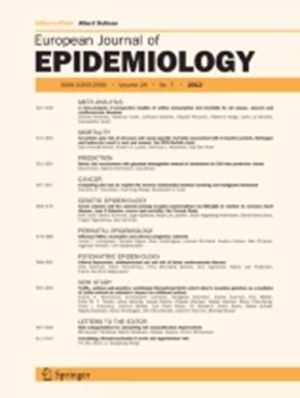An in-depth study of the correlation between Hashimoto's thyroiditis and Sjogren's syndrome: multiple evidences from large cohorts, Mendelian randomization, and transcriptomic analysis.
IF 5.9
1区 医学
Q1 PUBLIC, ENVIRONMENTAL & OCCUPATIONAL HEALTH
引用次数: 0
Abstract
The co-occurrence of Hashimoto's thyroiditis (HT) and Sjogren's syndrome (SS), two seemingly unrelated diseases that both affect huge amounts of people worldwide, has been indicated previously in several case reports. However, there is a lack of higher-level evidences proving their comorbidity, and the underlying mechanisms remain unelucidated. This in-depth study aims to provide evidences for the comorbidity between HT and SS and explore the genetic and immunological mechanisms that may underlie their occurrence. Leveraging large retrospective cohorts from the collaborative electronic health record database, matched by propensity scores, we evaluated the risk of developing SS in 190,653 patients with HT and the risk of developing HT in 73,306 patients with SS. A Mendelian randomization (MR) approach was applied to investigate the causal relationship between the two conditions. Transcriptomic analysis of GEO datasets further explored common immunological markers. Our large-scale propensity score-matched analysis revealed a significantly higher risk of SS in HT patients compared to controls, with a hazard ratio (HR) of 3.227 and a confidence interval (CI) of 2.987-3.486, over a 20-year follow-up period. Similarly, a reciprocal risk was observed, with SS patients at a higher risk of developing HT (HR, 2.780; CI, 2.568-3.009) compared to controls. In Mendelian randomization study, random-effects IVW method showed a potential causal effect of HT on SS (IVW OR = 1.871, 95% CI = 1.265-2.768; P = 0.002). Furthermore, transcriptomic analysis showed there were 127 common up-regulated differential expressed genes (DEGs) between HT and SS, accounting for 29.4% of upregulated DEGs in HT and 14.5% of upregulated DEGs. Common hub genes in HT and SS were also determined, including CD4, IFNG, CCR7, and ITGAM, suggesting a shared immunopathogenesis and highlighting potential therapeutic targets. Our findings revealed a strong correlation between HT and SS, supported by evidences from clinical cohorts, the genetical causal effect, and shared immunopathogenesis, offering new insights into the cooccurrence of the two diseases.桥本甲状腺炎与干燥综合征相关性的深入研究:来自大型队列、孟德尔随机化和转录组学分析的多重证据。
桥本甲状腺炎(HT)和干燥综合征(SS)这两种看似不相关的疾病在世界范围内都影响着大量的人,在以前的一些病例报告中已经指出了这两种疾病的共同发生。然而,缺乏更高水平的证据证明它们的共病性,潜在的机制仍然不清楚。本研究旨在为HT和SS的共病提供证据,并探讨其发生的遗传和免疫学机制。利用来自协作电子健康记录数据库的大型回顾性队列,通过倾向评分进行匹配,我们评估了190,653名HT患者发生SS的风险和73,306名SS患者发生HT的风险。采用孟德尔随机化(MR)方法研究了两种情况之间的因果关系。GEO数据集的转录组学分析进一步探索了常见的免疫标志物。我们的大规模倾向评分匹配分析显示,在20年的随访期间,HT患者发生SS的风险明显高于对照组,风险比(HR)为3.227,置信区间(CI)为2.987-3.486。同样,观察到相互风险,与对照组相比,SS患者发生HT的风险更高(HR, 2.780; CI, 2.568-3.009)。在孟德尔随机化研究中,随机效应IVW方法显示HT对SS有潜在的因果影响(IVW OR = 1.871, 95% CI = 1.265 ~ 2.768; P = 0.002)。此外,转录组学分析显示,HT和SS共有127个差异表达基因(deg)上调,分别占HT中上调deg的29.4%和上调deg的14.5%。HT和SS的共同枢纽基因包括CD4、IFNG、CCR7和ITGAM,这表明它们具有共同的免疫发病机制,并突出了潜在的治疗靶点。我们的研究结果揭示了HT和SS之间的强相关性,得到了临床队列证据、遗传因果效应和共同的免疫发病机制的支持,为两种疾病的共发提供了新的见解。
本文章由计算机程序翻译,如有差异,请以英文原文为准。
求助全文
约1分钟内获得全文
求助全文
来源期刊

European Journal of Epidemiology
医学-公共卫生、环境卫生与职业卫生
CiteScore
21.40
自引率
1.50%
发文量
109
审稿时长
6-12 weeks
期刊介绍:
The European Journal of Epidemiology, established in 1985, is a peer-reviewed publication that provides a platform for discussions on epidemiology in its broadest sense. It covers various aspects of epidemiologic research and statistical methods. The journal facilitates communication between researchers, educators, and practitioners in epidemiology, including those in clinical and community medicine. Contributions from diverse fields such as public health, preventive medicine, clinical medicine, health economics, and computational biology and data science, in relation to health and disease, are encouraged. While accepting submissions from all over the world, the journal particularly emphasizes European topics relevant to epidemiology. The published articles consist of empirical research findings, developments in methodology, and opinion pieces.
 求助内容:
求助内容: 应助结果提醒方式:
应助结果提醒方式:


